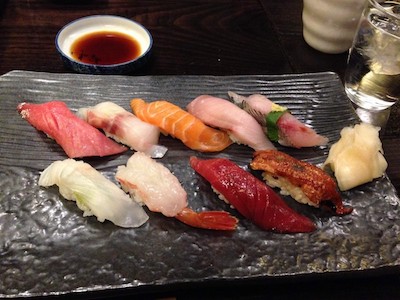We are reader supported. When you purchase through links on our site, we may earn an affiliate commission. Also, as an Amazon affiliate, we earn from qualifying purchases.
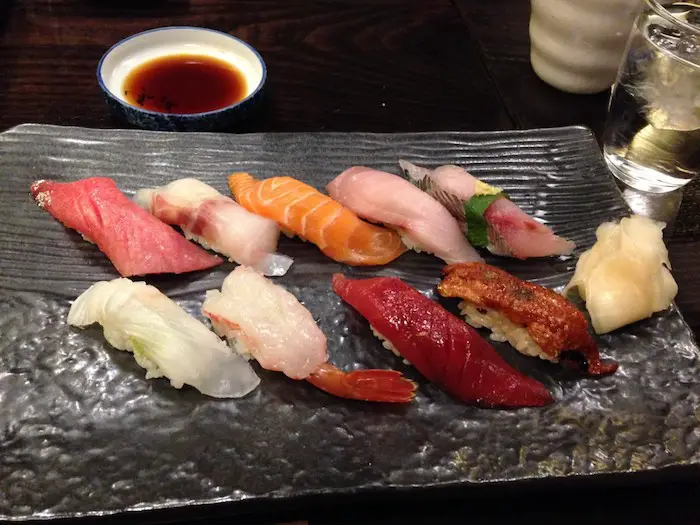
If you carefully look at the way people eat sushi at both low-end and high-end restaurants, you will see that some use chopsticks while others eat with their hands. I know there’s a lot being said about sushi etiquettes but it’s completely acceptable to eat sushi with your hands. Trust me on this!
Is sushi finger food then? Yes, you may call it so. Although ‘finger foods’ is more of a western thing, referring to the appetizers one can eat with fingers, sushi perfectly fits into that description. After all, you can pick a piece of nigiri or sushi roll with your fingers and put into your mouth as a whole.
The reason why people still shy away from calling sushi finger food is probably that many cultures look down upon eating with fingers. Even some sushi snobs disapprove of people not knowing how to use chopsticks to pick nigiri or sushi rolls, but you really don’t need to pay any heed to them.
However, let’s not forget that sushi is highly regarded for being an exquisite form of art created by chefs who sometimes take years to master it. So, calling it finger food may sound degrading to some. While my intention is not to shame the culinary art form, it just pertains to the way this food is eaten.
Contents
Nigiri Sushi Was Originally Created To Be Finger Food
When nigiri sushi first came into being, they were sold from street-side shops and carts, not fine dining restaurants. Before the 18th century, sushi was not a popular food but the era suddenly saw a sudden growth in food stalls and nigiri sushi was created to match the take-out menu.
Yohei Hanaya, who is considered as the father of sushi invented this special hand-pressed sushi known as nigirizushi. At that time, tuna was not as popular as it is today. The fish was abundantly available in the sea and it was cheap. So, Hanaya put together vinegared rice and tuna fillets to create the first form of finger food in Japan and it kicked off a tuna-craze.
The sheer beauty of nigirizushi made it more appealing to the hungry and busy pedestrians who were too busy to sit down and eat. This form of finger food became an easy and delicious option for them to eat quickly on the go.
The visual presentation combined with the freshness of tuna and quick preparation time made it an instant hit. Hanaya’s original nigiri sushi closely resembles the sushi you can find today at the restaurants. He also used a dollop of wasabi on his nigiri, a tradition that is still followed.
So, what was nigiri sushi at that time? It was certainly not a fine dining cuisine. It was a type of finger food served quickly and eaten mostly with hands. It was centuries later when sushi restaurant came into being and new ways of making sushi were developed.
With the diverse styles of sushi, new ways of eating were also created. The growing popularity of sushi and the demand for different styles led to the introduction of sushi in boxes, bowls, platters, and leaves. Although sushi has highly evolved throughout these years, the basic nigiri, maki and hand rolls can still be eaten with fingers.
Types Of Sushi That Can Be Eaten With Fingers
#1. Nigiri (Handmade sushi)
Nigiri means two fingers, but it refers to the way nigirizushi is formed and not how it is eaten. To eat nigiri with your hands, pick a piece using your middle finger and thumb on either side of sushi rice and place your index finger over fish. Turn the nigiri upside down, dip the fish part slightly into soy sauce and put it into your mouth.
How to make nigiri:
To prepare nigiri sushi at home, use a sharp Japanese knife like this to cut slices (about 5 mm thickness) of sushi-grade fish. Now, take a small ball of seasoned rice and shape it in an oval form. Add some wasabi over the rice bed and now press the rice and fish slice carefully to give it shape.
To learn more about nigiri and a step-by-step guide on how to make nigiri, read my article – Nigiri: All You Need To Know.
#2. Maki (Sushi Rolls)
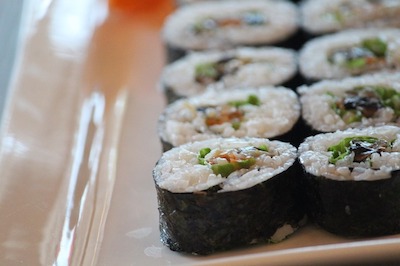
Maki sushi was created after nigiri, but this style surpassed the popularity of all other forms of sushi. No wonder, it’s the first that comes to the mind when someone says sushi. A maki roll is typically cut into 6-8 bite-size pieces that can be easily picked by hands or chopsticks.
Although the sushi traditionalists prefer eating sushi rolls with chopsticks, it’s perfectly acceptable to pick sushi roll pieces with your fingers. Just pick one piece, dip it in the soy sauce and put the entire thing into your mouth.
How to make maki roll:
You will need to buy a few things from the nearest Asian grocery store – a bamboo mat, a nice sushi knife, Nori (seaweed), short-grain rice, rice vinegar, and Japanese cucumber.
First, you need to cook the short-grain rice, let it cool and then season it with vinegar, salt, and sugar. I have created an article that provides step-by-step instructions on how to cook sushi rice in cooker and pot.
Peel the cucumber, cut it into half and make thin strips to be used as fillings. Now, lay the bamboo mat on the kitchen table and cover it with a plastic sheet. Put the nori sheet over the bamboo mat, rough side facing upwards.
Take half cup of vinegared rice and spread it over nori sheet, leaving a gap on the sides. Arrange cucumber strips towards the middle and roll up with the help of the sushi mat. I have created an article that talks about maki sushi and easy recipes you can make at home.
#3. Uramaki (Inside-out sushi rolls)
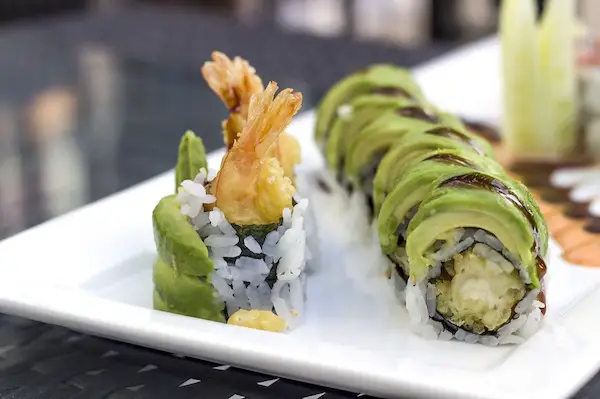
California roll is the best example of an inside-out sushi roll. This style was created to woo the westerners who did not like the appearance of greenish-black nori outside the maki rolls. So, the chef decided to hide nori inside the layer of sushi rice, and uramaki was born.
The uramaki roll not only contains fillings but it may also have a variety of toppings such as raw salmon, tuna, or veggies over the rice. Just like maki rolls, it is also cut into 6-8 bite-size pieces. While it’s possible to eat an uramaki with your hands, the westernized specialty rolls are often slathered with sauces on the top and this can make your hands dirty.
How to make uramaki at home:
To make inside-out sushi rolls at home, you can use the same supplies bought for maki rolls. Just after you spread sushi rice over the Nori, flip it over to have rice facing the bamboo mat and the other side of nori facing you. Put a strip of sushi-grade salmon and cucumber on the seaweed and start rolling with the help of the bamboo mat.
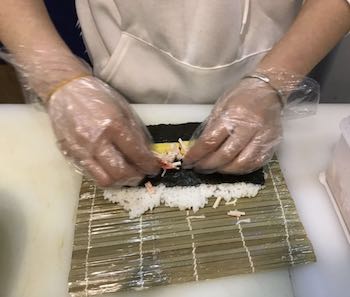
Cut thin slices of avocado and arrange them over the rice part of an uramaki roll. Put a plastic sheet over the roll and hug tightly with the help of a bamboo mat. Take a sharp Japanese knife and cut the roll into 6-8 pieces with the plastic on. Remove the plastic and serve.
Read that my article that contains step-by-step instructions on how to make inside-out California sushi rolls at home – how to make California rolls at home easy.
#4. Temaki (Hand rolls)
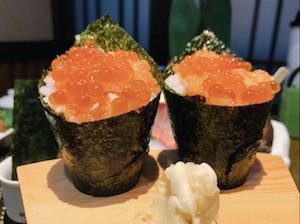
This style of sushi rolls is undoubtedly the ultimate finger food as you can’t imagine eating them with anything other than your hands. These are cone-shaped rolls that contain less sushi rice and delicious fillings to make a healthy and tasty snack loved by all.
How to make temaki rolls:
Cut the nori sheet into half and place the half part of seaweed on the kitchen table, shiny side down. Take a tablespoon of rice and spread it on the top right-hand corner of the nori in a rectangular shape. Now arrange strips of sushi-grade tuna, carrots, and cucumber diagonally over the sushi rice. Fold into a cone shape and seal the edges with a few drops of water.
I have created an article that explains in detail about temaki roll and the various recipes you can try at home – Sushi Handroll (Temaki Sushi) Recipe Guide.
5 Things That Make Sushi Finger Food
- Sushi pieces are small, sweet, and crisp. They can be eaten in one bite and are so light that you will still have room for more food.
- At a sushi bar, you can see a wet and warm towel placed on the table. It is meant to clean your hands before using them to eat your food and then wipe it again after you have finished eating.
- Sushi chefs suggest that nigiri can be best enjoyed when you eat with your hands. If you don’t know how to use chopsticks, it’s better to eat with hands than creating a mess while trying to use chopsticks.
- Like any finger food, presentation is an important aspect of sushi. They are garnished beautifully to make them more appealing to the customers.
- Nigiri sushi, maki rolls, and California sushi rolls can be bought from the grocery stores for a quick fix while you are on the move.
Related Questions
Can I use a fork if I don’t want to use my fingers?
Yes, you may. Many people simply do not like the idea of eating with their hands (particularly due to cultural influence). If you don’t know how to use chopsticks and also don’t like the idea of touching the food with your fingers, use a fork instead. Just make sure you don’t spoil the perfect form of nigiri with the fork. Read my article – can you eat sushi with a fork.
What are the other side dishes paired with sushi?
You may order miso soup with sushi. Eat the solid pieces in the soup by picking them up with a spoon or fork. You can drink the liquid part by holding the bowl close to your mouth. Edamame is another popular side dish served with sushi. To eat it, bring the pod closer to your mouth, pop open the pod and eat the beans inside it.
Do I need to follow sushi etiquettes?
The Japanese are very particular about their tradition, culture, and food. If you go to a sushi restaurant where the chef is Japanese you are in for luck because you will get to taste authentic cuisine. At the same time, you must be familiar with a few sushi etiquettes so that you don’t offend the culinary artist at work. Read my article on how to eat sushi in Japan (sushi eating etiquette).

